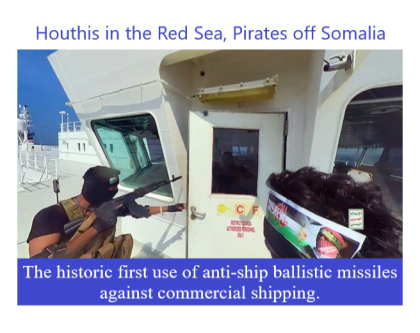Attacks on commercial cargo ships by the Houthi rebels around the Red Sea, as well as the return of piracy off the coast of Somalia, are causing concern for traders everywhere, especially with Chinese New Year holidays only weeks away. There is no clear leadership or agreement on how to tackle the crisis. Australian traders should be looking at what shipping and supply alternatives might be available to them.
Altogether, Houthis in Yemen have now launched more than 20 attacks on container ships using drones, ballistic missiles, and in one case, an explosive unoccupied vessel.
Calls have been mounting for the United Nations to step in. A statement issued by the UN Security Council said that the campaign waged by the Yemen-based, Iran-backed Houthi militia had included what the governments described as the “historic first use of anti-ship ballistic missiles” against commercial shipping.
It added that this was “a direct threat to the freedom of navigation that serves as the bedrock of global trade in one of the world’s most critical waterways.”
The initiative of the US Navy is proving insufficient to deter attacks on commercial shipping in the Red Sea. The US has seemingly failed to get its coalition partners onboard, with almost half of the parties who are involved refusing to publicly declare their participation.
In an interview with the Loadstar, Senior research fellow for Middle East security at the Royal United Services Institute, Tobias Borck, noted that Houthi claims of only attacking Israel-linked ships were “not stacking up”; the crew of a Japanese vessel headed for Italy have been held captive by the militia for more than 40 days. “The Houthis are declaring it safe for any vessel not tied to Israel, but that’s either not the case or they’re just not very good at determining which ships this includes,” he said.
Some of the large shipping lines have issued contradictory statements on their intended movements. Well-known LinkedIn commentator Lars Jensen posted yesterday […] that online information from the carriers related to Israel is presently not credible. Several global carriers do not show online services to Israel despite actually still operating them. This is likely done as a safety measure as it was done at a point where they had vessels transiting the risk area. Even if vessels transiting did not go to Israel it could be perceived as a safety risk if a routing from China to Israel was shown on mainline vessel X transhipping to feeder vessel Y in the Med – in this case Houthis might see vessel X as a target.
Today the Conversation carries an article which includes the sub-heading, It’s time to develop Plan B. It is written by Sanjoy Paul, Associate Professor, UTS Business School, University of Technology Sydney. He writes:
To minimise the impact of all of these disruptions, businesses need to develop backup plans that can be implemented quickly.
They include diversifying supply sources, being prepared to use alternative shipping routes and onshoring critical manufacturing.
Resources ought to be allocated now and planning done in collaboration with local and international partners.
The businesses that best prepare will be those best able to ride out and gain from the next disruption.
Yesterday, respected maritime advisory company Drewry wrote:
The next 4-5 weeks will be critical for global shipping and container traffic from Asia to Europe and Mediterranean to Asia. Any disruption ahead of Chinese New Year is always a concern for shippers and while the current situation is already causing bottlenecks in global supply chains, for the moment, we believe there is ample capacity to deal with the resulting congestion, equipment shortages and gaps to schedules. It should be noted, however, that container equipment is likely to remain displaced for some weeks to come, affecting service schedules and causing inflationary headwinds with limited flexibility to mitigate any escalation in the regional security situation.
Around 16% of Australia’s container imports – about A$60 billion in value – come from Europe, including pharmaceuticals, machinery, vehicles, electronic equipment and medical apparatus. Exports to the region are valued at A$23 billion, including mineral fuels, oils & distillation products, as well as wine, fruits, grain, seeds, nickel and aluminium. These are all affected by the Red Sea crisis.
With the aggression looking set to spread regionally in the Middle East rather than diminish, Australian importers and exporters should be thinking outside the box when making contingency plans. There is no caped crusader waiting in the wings to resolve this for us anytime soon.
Also see our related article: Red Sea & Suez: Next Supply Chain Crisis?
For more information about global trade and shipping contact us here at Colless Young. As licensed Customs Brokers and Freight Forwarders we offer correct, professional advice on all your import and export transactions. We are based in Brisbane and provide a complete range of logistics services, both airfreight and sea cargo, through all Australian ports and airports.

